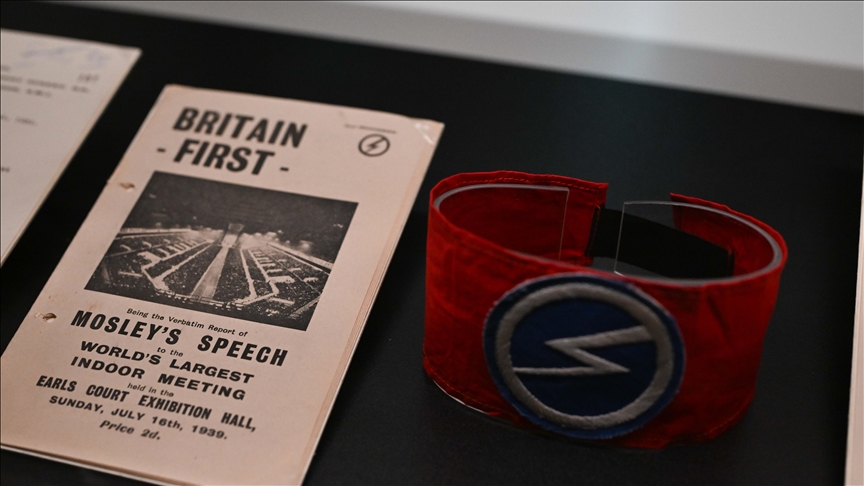Lemons, ciphers, and moles: Britain’s MI5 lets public in for first time
‘MI5: Official Secrets�� offers a rare look inside the inner workings of one of Britain’s most secretive institutions, from World War-era spycraft to modern-day counterterrorism
 The UK’s domestic intelligence service MI5 opens its vaults to the public for the first time
The UK’s domestic intelligence service MI5 opens its vaults to the public for the first time
- People hear the acronym MI5 and they ‘start thinking of James Bond and all that fantasy world,’ but ‘what we’re showing is the reality … the high points and low points,’ says exhibit curator Mark Dunton
LONDON
In a landmark collaboration, the UK’s domestic intelligence service MI5 has opened its vaults to the public for the first time, partnering with The National Archives to present an unprecedented exhibition on more than a century of covert operations.

The result is ‘MI5: Official Secrets,’ an exhibition that offers a rare look inside the inner workings of one of Britain’s most secretive institutions, from World War-era spycraft to modern-day counterterrorism.
The exhibit, now open at The National Archives in London, represents a milestone in British intelligence history.
“It really is a groundbreaking exhibition,” said Mark Dunton, a historian at The National Archives and curator of the show. “This is the first time that MI5 has collaborated with another institution about its history. We are breaking new ground.”
Spies, saboteurs, and a 110-year-old lemon
🔍 Britain’s MI5 opens doors to public for 1st time ⤵️
🕵🏻 ‘MI5: Official Secrets’ exhibition offers a rare look inside the inner workings of one of Britain’s most secretive institutions, from World War-era spycraft to modern-day counterterrorism https://t.co/d67d0aUu1K
The story begins in the prelude to World War I, tracing MI5’s evolution through two global conflicts, Cold War espionage, homegrown threats, and the digital age.
The objects on display are as compelling as they are unexpected, ranging from long-sealed surveillance files to physical artifacts that could have been pulled from the pages of a spy novel.
Among the highlights is a dried, blackened lemon – more than a century old – once used by German spy Karl Muller in 1915 to compose invisible messages in lemon juice.

“It is black, it is shriveled, it is compressed, but it forms part of our archive,” Dunton noted. “He was using lemon juice as invisible writing … in between the lines of what looked like an innocent business letter.”
Also featured is a concealed wireless transmitter uncovered in the home of the Krogers, a couple later unmasked as Soviet agents. “They were using that transmitter to send flash transmissions to Moscow – all kinds of secrets. There’s some really intriguing stuff in this exhibition,” Dunton said.
Visitors can also view Guy Burgess’s leather briefcase, left behind at the elite Reform Club before his infamous defection to the Soviet Union, and newly released documents detailing the 1963 confession of Kim Philby, another of the notorious Cambridge Five double agents.
Beyond Bond and fantasy
Far from the glamourized world of James Bond, the exhibition immerses visitors in the painstaking reality of counterintelligence, revealing the day-to-day tools of the trade: transcripts of bugged phone calls, surveillance reports from agents tailing suspects, and photographs pulled from once-classified MI5 files.

“I’ve just seen people every day poring over these files, fascinated by the detail in them … transcripts derived from listening devices, or surveillance reports from MI5 watchers who’ve been trailing people in the streets,” said Dunton.
Twenty facsimile case files, recreated in detail, allow visitors to step into the shoes of an MI5 analyst. The files contain real stories of threats thwarted, infiltrations exposed, and missteps acknowledged.
One of the exhibition’s central themes is demystifying MI5’s role.
“Some people … hear the acronym MI5, and they immediately start thinking of James Bond and all that fantasy world,” said Dunton.
“But in the exhibition, I think what we’re showing is some of the reality of MI5 work … the high points and low points.”
Triumphs and failures in equal measure
As Dunton points out, the exhibition does not shy away from MI5’s missteps, acknowledging the profound damage caused by Cold War breaches and failures such as the infiltration by the Cambridge Five.
At the same time, the exhibition highlights some of the service’s greatest triumphs, including the Double Cross operation, which turned captured German spies into double agents during World War II.
To enrich the narrative, the exhibition incorporates video interviews with former MI5 directors-general, intelligence historian Christopher Andrew, and political figures like former UK Prime Minister Theresa May, who served for six years as home secretary, the minister responsible for overseeing MI5.
The show also pays tribute to the early architects of Britain’s domestic intelligence network. Vernon Kell, MI5’s founding director, is honored for his decades of leadership, while William Melville – one of the original spy chiefs who helped establish MI5’s precursor organizations – is spotlighted for his foundational role in British security.
While the National Archives has long received declassified MI5 documents, the exhibit marks the first time the agency has agreed to co-curate and publicly present a comprehensive account of its work.
“As part of those conversations, we came up with the idea … wouldn’t it be good if we could have an exhibition to showcase some of these amazing documents?” Dunton recalled.
“And they came back to us and said, ‘Yes, we agree,’ and so it went from there.”
Anadolu Agency website contains only a portion of the news stories offered to subscribers in the AA News Broadcasting System (HAS), and in summarized form. Please contact us for subscription options.







